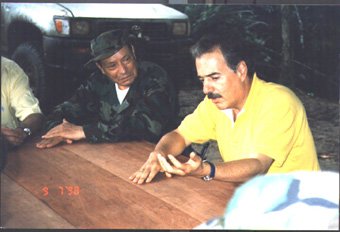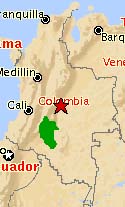Peace
Timeline: Pre-1999
1999
| 2000 | 2001 | 2002
October
1997
In a non-binding
ballot accompanying municipal elections, the vast majority of voters
-- 10 million Colombians in all -- voice support for a peaceful end
to Colombia's conflict.
May
1998
On the
one-year anniversary of the murder of two human rights workers, thousands
of Colombians take to the streets to demand peace. The peaceful protests
are the largest in Bogotá in decades.
June
15, 1998
With popular
clamor growing for a peaceful resolution of the conflict, peace becomes
a key issue in Colombia's ongoing presidential campaign. Candidate Andrés
Pastrana reveals that an emissary, future High Commissioner for Peace
Víctor G. Ricardo, met with Revolutionary Armed Forces of Colombia (FARC)
leader Manuel Marulanda Vélez (alias "Tirofijo," or "Sureshot").
July
9, 1998
 |
Pastrana
(right), now president-elect, travels to the mountains of rural
Colombia to meet with FARC leaders, including Marulanda (left). |
July
15, 1998
Two leaders
of the National Liberation Army (ELN, Colombia's second-largest guerrilla
group) sign an agreement in Mainz, Germany, with forty Colombian business
and civil-society leaders. The "Puerta del Cielo" accord commits
the ELN to finding a peaceful solution to the conflict, particularly
through the hosting of a "convention" with civil-society and
government leaders at some future date.
July
26, 1998
| A
group of labor, business and civil-society leaders meets with paramilitary
representatives in Nudo de Paramillo, the headquarters of paramilitary
leader Carlos Castaño. The resulting "Nudo de Paramillo Accord"
expresses paramilitary support for an eventual peace negotiation
and for an end to attacks on civilian populations. |

Carlos
Castaño
|
July
30-31, 1998
 |
Civil-society
groups host a "Permanent Assembly for Peace" in Bogotá.
The event, designed to increase non-governmental participation in
Colombia's peace process, draws more than three times the expected
number of participants. |
October
8, 1998
| Government
and guerrilla representatives continue discussions about a FARC
proposal to pull all security forces out of five municipalities
in southern Colombia, creating a temporary "clearance zone"
for the holding of peace talks. The municipalities are Vistahermosa,
La Macarena, Uribe, and Mesetas in Meta department, and San Vicente
del Caguán in Caquetá department.
The
guerrillas' clearance plan requires that the "Cazadores"
Infantry Battalion vacate their headquarters in San Vicente del
Caguán, Caquetá. The government, however, insists that the 130
troops stationed there be allowed to remain.
|

Approximate
location of FARC "clearance zone" (in green; map from
MapQuest)
|
October
11-12, 1998
The ELN
meets again with Colombian business and civil-society leaders, this
time in "the mountains of Colombia" (made possible by a temporary
pullback of Army troops). The ELN agrees to develop its negotiating
agenda by hosting a "convention" in Colombia in February 1999,
attended by hundreds of civil society and government representatives.
October
15, 1998
The government
and FARC agree to demilitarize the five municipalities, except for the
Cazadores Battalion. While the government pushes for the presence of
unarmed soldiers at the Battalion, the FARC insists on a full demilitarization.
October
18, 1998
The ELN
peace process is dealt a severe blow after the group blows up an oil
pipeline in Machuca, Antioquia state, accidentally triggering a fireball
which kills at least 45 people.
November
7, 1998
The first
90-day demilitarization period officially begins in the five municipalities
where talks with the FARC are to occur. Except for those stationed in
the Cazadores Battalion, all soldiers and housed police in the newly
demilitarized zone are recalled. The FARC conditions the start of official
talks on the removal of the Cazadores Battalion and on government agreement
to a controversial prisoner exchange.
December
1, 1998
Attending
the Defense Ministerial of the Americas in Cartagena, U.S. Defense Secretary
William Cohen meets with his counterpart, Colombian Defense Minister
Rodrigo Lloreda. The officials sign an agreement for closer U.S.-Colombian
military cooperation. The agreement creates a formal Bilateral Working
Group between both countries' armed forces, which is to meet periodically,
and pledges U.S. assistance for the creation of a counternarcotics battalion
within the Colombian Army.
December
13-14, 1998
Philip
Chicola of the U.S. State Department's Andean Affairs Office meets secretly
in Costa Rica with FARC representative Raúl Reyes. The meeting was requested
by the FARC via the Colombian government. Chicola conveyed the U.S.
government's will to continue pursuing its counter-drug strategy in
Colombia, and urged the FARC to halt aggression against U.S. citizens
in Colombia and to demonstrate a clearer commitment to the peace process.
December
14, 1998
FARC leader
"Tirofijo" and Ricardo agree to hold talks between the two
parties beginning January 7, 1999. Ricardo agrees to withdraw the Cazadores
Battalion, apparently without consulting the army.
1999
| 2000 | 2001 | 2002
See
also:
"An Overview of Recent Colombian History,"
from the Colombia Human Rights Network website.
"Colombia: A
Country Study" - US Library of Congress
State
Department Background Notes: Colombia
CIA World
Factbook 1998: Colombia
CIP's
New and Noteworthy
Page, including links to current Colombia news
|

